Understanding the Spanish Mastiff, Also Known as Mastín Español
The Spanish Mastiff, or Mastín Español, is a magnificent giant breed originating from Spain. Traditionally bred as a livestock guardian dog, this powerful and intelligent breed has played an essential role in protecting flocks of sheep from predators such as wolves for centuries. Their story is deeply woven into the agricultural and cultural fabric of the Iberian Peninsula.
Origins and Historical Significance
The Mastín Español boasts a heritage dating back over 2,000 years, with its ancestors believed to have accompanied early settlers to the Iberian Peninsula. During medieval times, these dogs were vital participants in the transhumance, joining migratory herds of Merino sheep across Spain. Their role was pivotal—guarding livestock, property, and providing invaluable company on long journeys with drovers and shepherds.
Physical Characteristics
This breed is immediately recognizable due to its sheer size and impressive physique. Mature males can stand 28–35 inches tall and weigh between 140 and 220 pounds, often making them one of the largest dog breeds globally. Key physical traits include:
- Large head with a broad skull and strong jaws
- Loose, thick skin around the neck forming a characteristic dewlap
- Short to semi-long dense coat in varied colors: fawn, red, yellow, black, wolfgray, brindle, or white with or without markings
- Small dark hazel or brown eyes
- Medium-sized triangular ears that hang close to the head
Temperament and Behavior
The Spanish Mastiff is known for its calm, intelligent, and independent temperament. They form strong bonds with their families and adopt a watchful stance toward strangers. Their demeanor makes them excellent natural guard dogs. However, their large size and protective instincts mean that they:
- Are best suited for experienced dog owners with confident handling skills
- Require extensive early socialization and obedience training
- May display dominance or aggressiveness towards unfamiliar dogs if not socialized
- Are typically gentle and patient with children, but due to their stature, supervision is key
Exercise and Living Requirements
While they are not highly energetic, the Spanish Mastiff needs at least an hour of exercise daily. They thrive best in rural or spacious environments where they can stretch out and roam freely.
- Long, secure walks or expansive playtime are ideal
- Apartment living is not recommended due to size and activity needs
- Strong fences are advised to prevent roaming behavior
Training and Mental Stimulation
Being intelligent yet independent, they can be a challenge for novice dog owners. Proper training involves:
- Positive reinforcement techniques
- Consistent boundaries and firm, calm leadership
- Exposure to diverse people and pets to reduce over-guarding tendencies
Grooming Needs
Grooming a Spanish Mastiff isn’t overly demanding but requires regular attention:
- Weekly brushing (more during shedding seasons)
- Occasional baths
- Regular inspection and cleaning of neck folds and ears
- Dental hygiene and nail care to avoid complications
Health Considerations
Due to its size, the breed is susceptible to specific health issues:
- Hip and elbow dysplasia
- Gastric dilatation-volvulus (bloat)
- Heart issues – including cardiomyopathy
- Skin infections especially in folds
- Eye disorders like entropion
- Hypothyroidism and certain cancers
Feeding preventive healthcare, such as appropriate diets, slow feeding practices, and potential gastropexy surgery, can extend their lifespan, which typically ranges from 9 to 12 years.
Diet and Nutrition
This breed needs high-quality large-breed-specific diets matched to their life stage. Portion control is essential to avoid obesity and joint stress. Multiple small meals, minimal vigorous activity post feeding, and the use of slow-feeders help manage common digestive risks.
The Ideal Owner for a Spanish Mastiff
Mastín Español is not an ideal choice for novice dog owners. Their independent thinking, silent strength, and guarding instinct necessitate a confident, informed, and experienced hand. People with large properties, livestock, and the time and patience to train a large dog will thrive with one of these noble giants.
Final Thoughts
The Spanish Mastiff, or Mastín Español, is a loyal, ancient guardian breed with immense physical and mental stature. With the right owner, environment, and guidance, they transform into gentle, steadfast, dignified companions and protectors. Ideal for rural homes or working farms, this breed flourishes with meaningful structure and loving leadership.





